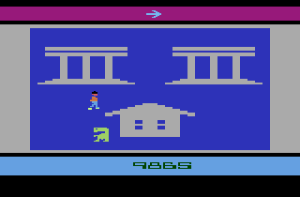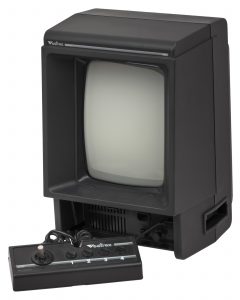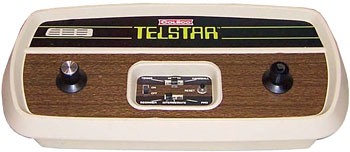ContentCoup.com
May 5, 2020

Pac-Man was the first international celebrity in video game history. Japanese developer Namco first released the arcade version of the game in May of 1980. Midway Games spotted Pac-Man at the 1980 Amusement and Music Operators Association (AMOA) expo. They began distributing the game in North America later that year. The rest, as they say, is history.
Pac-Man spawned all kinds of merchandise, a Saturday morning cartoon, and even a Billboard Hot 100 top 10 single, “Pac-Man Fever,” in March of 1982.
The video game industry, anchored by Pac-Man, grossed more in revenues than all Hollywood films and pop music combined in 1982. Arcade games like Space Invaders (developed by Taito), Defender (Williams Electronics), Donkey Kong (Nintendo) and Q*bert (Gottlieb) were huge successes as well. The gaming industry appeared indestructible. But Namco granted Atari the exclusive right to create home versions of their arcade games sometime in the late 1970s. The agreement almost killed an entire industry.
Bubble burst in 1983
The much-anticipated release of Pac-Man for the Atari VCS (later renamed Atari 2600) happened in March of 1982. The game ended up selling seven million copies, mostly on name recognition. But critics were not impressed. They lambasted the game for its terrible graphics and awful design. Meanwhile Intellivision, Colecovision, Commodore 64, Apple II, TI-99, and other home computer and gaming systems were trying to make their marks in the industry.
Atari attempted to redeem itself later that year. The company was granted a license to make the hit movie “E.T. the Extra Terrestrial” into a video game. But Atari executives wanted the game developed and completed before the holiday season. Thus the company developed and released the disaster of a game in six weeks, without any quality testing it at all, to ensure huge Christmas sales.
Atari received most of the blame for the video game crash of 1983. The company ended up dumping millions of unsold cartridges and consoles into a landfill in Alamogoro, New Mexico that year. The industry grossed $3.2 billion in sales in 1982. That number dropped to $100 million by 1985. Over-saturation and bad game design overall also contributed to the crash. Bowling alleys and arcades kept the gaming industry afloat until the Nintendo Entertainment System rescued it in 1986.
The gaming industry grossed upwards of $150 billion in 2019, depending on the source. Mobile gaming is the biggest earner, followed by PC gaming and home consoles. These figures also include augmented and virtual reality revenues, both of which are fast becoming major players in gaming.
Game developer Tyrone Evans Clark talks past and future of gaming

Tyrone Evans Clark is an actor, video game developer and 3D animation artist. He’s worked for Disney Interactive, Storymind Entertainment, Greenhouse GFX and on several individual projects for other companies. We asked him about the video game crash of 1983 and how he sees the future of the gaming industry.
Content Coup: What are your impressions of first-generation gaming consoles like Magnovox Odyssey and Coleco Telstar? What about the second generation like Atari 2600, ColecoVision and Intellivision?
Clark: Odyssey was ok but you had to put a plastic screen on the television for you to know you were playing a different game. I give it about a C+ as far as graphics and game play. It was pretty cool for it’s time. Vectrex was original.

It had this vector screen where you saw everything as an “etch,” like the old Etch A Stetch with the sand inside. That was the whole style of the system – etchings. It was pretty cool, but didn’t do near as well as Atari and ColecoVision.
I respect Atari because it started as a game company. Coleco started off doing different stuff, then started making games. I respect ColecoVision because they partnered with Nintendo to make great games like Donkey Kong. Atari is still making games today. Centipede, Asteroids and Pong put Atari on the map. Dragon Ball Z came along later. The list goes on for Atari. I’m still a fan of Atari and can’t let go of it. They are a respected company that started off making games and that’s why they’re still successful today.
CC: What was your first home video game system? What games did you enjoy most on them? What made a game “good” in your view when you were a child?
Clark: My first system was the Nintendo Entertainment System when I was 7-8 years ago. Mario Bros. was probably my favorite game. I remember Duck Hunt with the gun. The graphics were kick-ass. I just couldn’t put down the controller. Games with characters were the best. Mario eating mushrooms and saving the princess from Mr. Koopa was everything for me. The graphics and interaction with the characters made a good game for me.
CC: Most people blame poor game design and a flooded market that caused the 1983 video game crash. Some place the blame squarely on that horrible E.T. game for Atari 2600 that was completely pointless. Sales dropped from $3.2 billion in 1982 to just $100 million the following year. Why do you think the crash happened?
Timing was the issue. Pricing was also an issue. People went to arcades, skating rinks and bowling alleys to play games for $0.25. That was a social norm in the 1980s. The crash happened because people couldn’t afford the systems. The poor timing means taking a game in an arcade, and trying to turn it into a game system that people can buy around the world. Many mistakes were made. It’s like Coleco Telstar.

They decided to do a system on a whim and it just didn’t work out. They eventually evolved the entire franchise and came up with ColecoVision.

Sometimes you have to fall on your butt to be successful.
CC: Video games are far more advance in 2020 than the console in 1983. What makes a video game successful in 2020? What’s most important – graphics, story lines, pricing, etc.?
Clark: There are more gamers now. People play games to relieve stress, to feel happy. You can go on a video game like “Grand Theft Auto” and shoot people up to relieve anger. You can have sex with avatars in games today, where you’re literally mimicking the thrusts to display them on the screen. Technology has advanced in so many ways.
The military uses this same technology to train troops, people use it to learn how to dance, workout videos, losing weight, being able to communicate with the world, artificial intelligence. Story line is so important and the technology facilitates that. When you give characters depth, background and stories, it’s a big thing.
People want characters they can relate to. People like Mario because he is Italian, like mushrooms, and saves a Princess. Sonic the Hedgehog was huge because of the character. It’s all about story lines and characters.
CC: Autodesk first released Maya in 1998. 3D Studio Max was released in 1996. How did these applications change the gaming industry?
First of all, the graphics. Accessibility allows people to create their own content. Now we have open source software where people can make their own stuff, like Blender, that is free to the public. These apps pushed the envelope on so many levels – creating CAD models, assets, meshes for games, controlling polycounts, crunching polygons for video games.
You can control the amount of realism in games, and the amount of fantasy. People now know more about games than ever. There’s more behind it than just graphics. You have to have artistic appeal. I respect Autodesk because they have great customer service that answers questions and provide tutorials. These apps completely revolutionized gaming.
CC: What are some games you have contributed to as far as creation? What are/were some of your favorite projects?
Clark: Good question. I’ve worked on so many. “My Eyes On You” for Xbox One, PS4. It’s a third-person action-adventure, a fantasy, shoot-em-up game. It’s based in the slums in Chicago, which is where I’m from. I also loved working on “Eden Fallen” by Razor Edge games. It’s also fantasy, apocalyptic, dark, disturbing. I love that kind of stuff. My life was not always a fairy tale and these types of games related to me.
The Disney Infinity franchise, “Dungeons and Dragons,” “WWE Smackdown vs. Raw,” “Transformers: Revenge of the Fallen” are some others. I like action games. The graphics have to be kick ass. I also love games that challenge my skill sets. I have more projects coming up. But I cannot disclose them due to agreement. But there are a lot more on the way.
CC: Video games in 2020 appear to be recession-proof, unlike in 1983. How has the gaming community changed society? What does the future of game design look like as AR and VR advance?
Clark: People are able to be the characters they love. You’re adding something to your reality with AR. You’re adding yourself to the reality with VR. Put those two together, you have mixed reality. There’s also XR, extended reality. That’s a combination of all of them.
Everything is geared towards making the player, the actual character. Instead of just playing Halo, you ARE Halo. You are the Superman. You are the Iron Man. You are the Black Panther. You are the Wonder Woman. That’s where it’s going. People want a place to escape. Some people want a friend, especially during the coronavirus season. Gaming technology allows people to have imaginary friends. They already did it with Pokemon Go.
True story, a guy was so obsessed with Pokemon, it ended up killing him. He fell off a bridge trying to catch a Pokemon. They have conventions and communities. People are really into it. Being able to add yourself to that world takes gaming to another level.
It’s all about applications for smartphones. But these technologies are also used for real-life experiences. It’s not just for video games. I’m honored and privileged to work with this technology. It’s not going anywhere anytime soon. If they don’t use AR/VR for video games, they’ll use it for something else. Games are here to stay.
It was such an honor being interviewed by you. I’m looking forward to working with you again in the future hopefully sometime soon. Thanks a million! TEC 😉